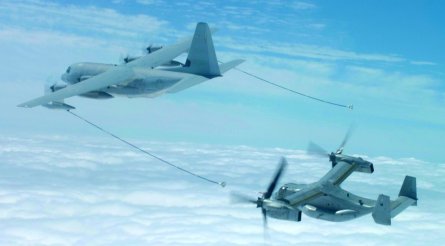By Andrew Doyle in London
Additional reporting by graham warwick
US Marine Corps crews last week performed two non-stop, coast-to-coast flights across the USA using a pair of Bell-Boeing MV-22 Osprey tiltrotors, as part of preparations to fly the aircraft across the Atlantic for July’s Royal International Air Tattoo and Farnborough International Air Show.
“Unlike conventional rotary wing aircraft, which must be transported into overseas theatres of operation aboard amphibious shipping or heavy-lift transport planes, the V-22 can self-deploy thousands of miles over water to get itself to the fight,” says Col Bill Taylor, V-22 Osprey joint programme manager. The MV-22’s first combat deployment is scheduled for 2007.
|
|
|---|
| Both tiltrotors refuelled twice during the coast-to-coast flights |
Marine Tiltrotor Operational Test and Evaluation Squadron 22 (VMX-22) dispatched two Ospreys from their base at Marine Corps Air Station New River, North Carolina on 19 June, and they landed at Marine Corps Air Station Miramar, California 9h later after flying 2,100nm (3,900km).
They returned to New River on 22 June, completing the flight in only 8h. The aircraft flew at up to 16,000ft (4,900m) at ground speeds of up to 300kt (550kmh). The crews completed two aerial refuellings using KC-130J tankers. “We didn’t have to do two aerial refuellings, but we wanted to fill up those [auxiliary fuel tanks] and burn them out a couple times, to increase our experience with the systems,” says Lt Col Chris Seymour, VMX-22 executive officer and pilot of one of the Ospreys.
Col Taylor says the internal auxiliary tanks that will be demonstrated on next month’s transatlantic flights could enable the Marine Corps to deploy the MV-22B operationally sooner than planned.
The current “baseline threshold” initial operational capability is targeted for September 2007, based on having a squadron with 12 Block B aircraft trained, equipped and ready for fleet deployment on an LHD assault carrier. But the first squadron will have 9 Block Bs by November and 12 by February next year, and the internal auxiliary tanks and aerial refuelling would give the Marine Corps the capability to self-deploy and – if they chose to – the ability to send the MV-22 to an operational theatre earlier than the scheduled initial operational capability.
Source: Flight International




















